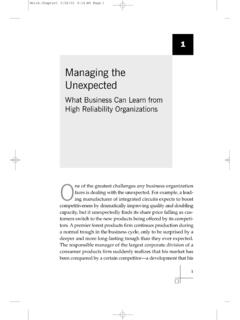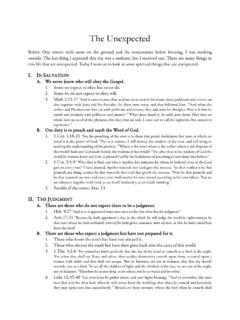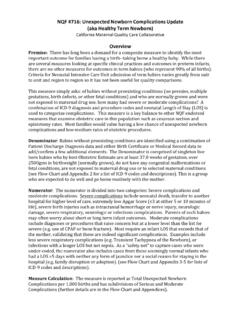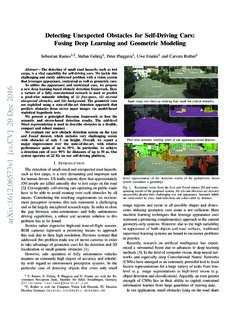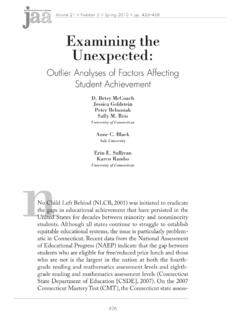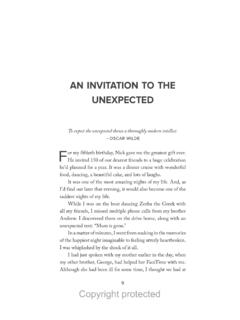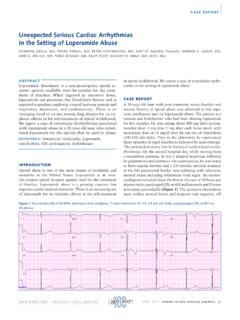Transcription of From Alan Cienki and Cornelia Müller (eds.), Metaphor and ...
1 From Alan Cienki and Cornelia M ller (eds.), Metaphor and Gesture, pp. 155-170. John Benjamins, Amsterdam. Fig. 1 Conduit metaphoric gesture accompanying and the next scene is in speech. Fig. 2. Process as motion metaphoric gesture accompanying the speaker s utterance of the dynamics of how you get through the* # right? unexpected METAPHORS1 David McNeill, University of Chicago I shall explain what I mean by unexpected metaphors in due course but I begin with a more familiar type, the expected Metaphor . So doing will set the stage and clarify what is actually unexpected about unexpected metaphors. Expected metaphors The hallmark of an expected Metaphor is that it follows an established cultural pat-tern. Such a Metaphor can appear verbally as well as gesturally, although not necessarily in the same utterance. It is expected in the sense that, given a repertoire of metaphors embodied in a culture, form and con-tent are more or less predictable.
2 The accompanying drawings2 present ex-amples of such gestures. Figure 1 illustrates, in a gesture, what Reddy (1979) called the conduit Metaphor in spoken and written language. The gesture displays the image of a container or substance, an image that embodies the idea of the next scene in this case. The speaker s open, upright palm is or contains this scene. Conduit metaphors are widespread but do not appear in all cultures (cf. McNeill 1992). Although in principle speech could have conveyed this Metaphor it did not (presumably to avoid cumbersomeness). Also, as is again often the case, the gesture carried information related to the meta-level of discourse the reference was to the structure, qua structure, of the story being recounted. The second illustration (Figure 2) includes two metaphors bundled into one gesture time is a moving object, in this case the temporal dynamics of a computer program, displayed as the speaker s own transverse motion, joined by a Metaphor in which a process is a rotation (example due to Eve Sweetser).
3 The combination metaphorizes what was also in speech, the dynamics (metaphorically, a rotation of D. McNeill unexpected Metaphors 2 Fig. 3. Iconic gesture with and drops it down the drainpipe the object being thrust down, a bowling ball, is also a Metaphor for the concept of an antagonistic force. hands) of how you get through (metaphorically, a transverse motion of whole body) . Again, the metaphors are in gesture only or at least the rotation Metaphor is gestural only. Expected metaphoric gestures have been widely studied (for example, McNeill 1992, Webb 1996, Cienki 1998, Parrill & Sweetser 2004, M ller 2004, this volume). Cultural standards and the potential for counterparts in speech set expected metaphors apart from the unexpected metaphors, described next. unexpected metaphors Metaphoric thinking is not limited to cultural metaphors like the conduit or time is a moving object. There are other gestures that seem at first purely iconic, not metaphoric at all, but on examination turn out to incorporate metaphoric thinking.
4 This metaphoric content is fleeting, one-off, and created afresh and instantaneously, as one speaks. Such gestures suggest a mode of thinking that is fundamentally metaphoric but also spontaneous and improvisational. The obviously iconic gesture of a bowling ball being thrust down (Figure 3), in an oft-examined example ( , McNeill & Duncan 2000), presents both an image of thrusting down and an abstract idea in the form of this image (an idea, I will explain shortly, of an antagonistic force). This essay examines this and other examples of such unexpected metaphors; identifies their role in speech, thought, and discourse; and aims to uncover some of the functions that explain how and why they occur. unexpected metaphoric gestures are not random. I propose they have both a discourse and an utterance creation function. They form a bridge between the core idea unit or growth point of the utterance at the moment of speaking, and the larger discourse framework.
5 In this way, these gestures, because they are metaphors, help to maintain the coherence of the idea units in question with respect to the larger discourse, and organize speech output itself within this discourse. unexpected metaphors also complete growth points by providing the imagery they require in combination with linguistic content. Expected metaphoric gestures have the same potential, and the two kinds expected and unexpected can be seen as two manifestations of the imagery-language dialectic as it engages abstract content, in the one case the culture providing the imagery ready-made and in the other the individual speaker generating it iconically and investing it with metaphoric significance on her own. The logic is that unexpected metaphors arise from the need to create images when the culture does not have them readily at hand. These images join linguistic content as growth points and differentiate what Vygotsky (1987) called psychological predicates, or points of contrast in the immediate ongoing context of speaking.
6 unexpected metaphors, precisely because they are outside the conventions of language and culture, can capture abstractions in novel ways and provide the fluidity of thought and language that is the essence of ongoing discourse. D. McNeill unexpected Metaphors 3 I would not want to say that such metaphors are derived from or based upon iconicity even though iconicity is present; instead, like Lakoff & Johnson, I imagine that we think in terms of these metaphors directly. The iconicity aspect is important for a different reason. When the idea is abstract, when, that is, strictly speaking it is nonimageable, the aforementioned dialectic, to take place at all, draws on metaphoricity. This is how metaphoricity comes in it fulfills an imagery-language dialectic. So, to quote Nobuhiro Furuyama (from an email communication), iconicity is a crucial part of metaphoric semiosis. But, if anything, Metaphor sets the stage for iconicity, rather than the other way around.
7 When the culture provides an image ready-made, we have an expected Metaphor . When it does not and the speaker, fulfilling the imperative of the dialectic, sees the image as something else, we have an unexpected Metaphor (cf. M ller s tripartite theory of Metaphor : it is this seeing the image as something else that conveys that a Metaphor is present). The bowling ball Metaphor I have presented this example in the past as a case study of the growth point and how the growth point incorporates context ( , McNeill 2000). Now I shall bring out what has been implicit in this example, that the gesture is also an unexpected Metaphor . The gesture (Fig. 3) is iconic for the bowling ball being thrust down, but it also is a Metaphor of the idea of an antagonistic force. The speaker has just watched an animated color cartoon (one of the Sylvester and Tweety sagas, Canary Row), and is recounting it to a listener, who has not seen the cartoon but will retell it from the first speaker s rendition.
8 There was no mention of gesture in the instructions to the participants the task was described as storytelling. The spoken part of the example is shown in line (2) below (line (1) will be referred to later). The first thing to notice is that the timing of the gesture stroke (boldface) is somewhat off, if we think gestures should line up with lexical affiliates. The stroke excluded the verb, drops ; it coincided with it down , and in this way combined two constituents, the Figure and Satellite (using Talmy s 2000 categories), but excluded another, the Activating Process, which in the sentence structure actually comprises a unit more tightly coupled with the Figure (numbers here and below refer to the sequential order of the utterance in the narration):3 (1) he tries going [up] [the insid][e of the drainpipe] and Tweety Bird runs (2) and gets a bowling b[all and drops it down the drainpipe] (brackets showing the onset and completion of the gesture phrase; boldface the gesture stroke; underlining pre- and poststroke holds).
9 This timing is not a mystery, however, if we regard the gesture as a Metaphor for an antagonistic force. From this vantage point the synchronized gesture and linguistic segments agree precisely. The it indexes the bowling ball, which metaphorizes the antagonistic force, and the down refers to the direction the force is taking. The verb, drops , in contrast, refers to Tweety, the character who was the agent of the dropping or thrusting but not the force in In short, drops was outside the Metaphor and was accordingly excluded from the gesture that carried the metaphoric meaning. D. McNeill unexpected Metaphors 4 The exclusion of drops was no mere slippage; timing of gesture and speech shows that it was motivated. First, the preparation phase has two features that skip the verb. Preparation began at the first mention of the bowling ball in the preceding clause. This shows that the bowling ball was already the focus.
10 And preparation continued right through the verb, suggesting that the verb was irrelevant to this focus. Further, a brief prestroke hold seems to have preceded it down (although coding varies), which, if present, targeted the stroke on the it down . Finally, an unmistakable poststroke hold lasted exactly as long as it took to complete the articulation of down , preserving the semantic synchrony of the gesture stroke with the articulation of the downward path in speech. So the stroke fully and exactly timed with just two words, it down , and excluded the lexically affiliated third, drops . The question is: why? Catchments How can we tell, in general, what unexpected metaphoric meaning a gesture may have, or that it has such a meaning at all? For this, we must look to the context prevailing at the moment of the gesture. The curved two-handed gesture was part of a family of similar gestures, a catchment.

